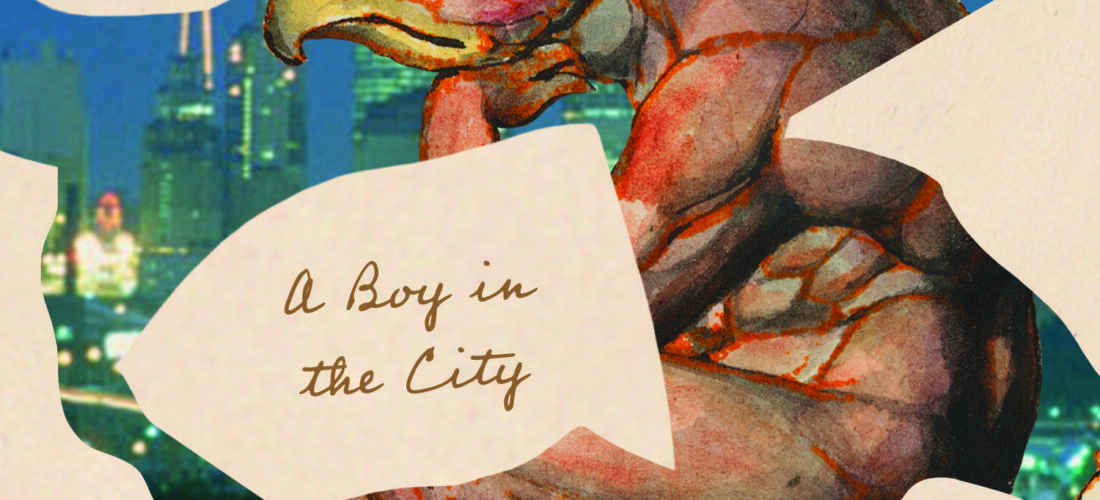S. Yarberry communicates the struggles of self-discovery and self-realization through their evocative debut poetry collection A Boy in the City. Navigating both their romantic and sexual relationships as well as their meditative interior monologue, Yarberry recreates the world in visionary verse; they offer an alternative lens through which to view our modern condition.
Much of the collection is bolstered by their polished, and not unrecognized, literary technique: their poetry has been published in lauded journals including Adroit Journal, Lily Magazine of the Washington Post, and AGNI, andwas also featured in Queer Voices: Prose, Poetry, and Pride, published by the Minnesota Historical Press in 2019. They currently serve as Poetry Editor at The Spectacle and the Poetry Coordinator at the MFA App Review, in addition to their undergraduate teaching experience at Washington University in St. Louis and Northwestern University.
In short, their resume is studded. I am hesitant to classify them as a young intellectual, as doing so might suggest that their poetry was pretentious, and possibly inscrutable; but I would be lying if I said that such thoughts didn’t trouble me when I first read through the collection. Yarberry opens their collection with an excerpt from The Book of Urizen by William Blake, and is peppered with references to Dante’s Inferno, the Odyssey, and, of course, other poems by Blake himself. Although I personally found their poems relatable and pleasing on aesthetic, linguistic, and intellectual levels, was that because I was raised in the same type of intellectual milieu? I remember feeling the fountain pen rolling around in my hand, as if it was the smoking gun that betrayed me.
To be honest, I don’t know if “intellectual” poetry is necessarily a problem; I don’t even know what role poetry should play in the emotional education of the youth. We are surrounded by so many iterations of what it could be, from Rupi Kaur’s notorious “Milk and Honey” collection, to the poetry publications of celebrities such as Lana Del Rey and James Franco that many self-proclaimed intellectuals gleefully deride. On the other side of the spectrum are the poems published by literary journals, many of which read as stiff and emotionally distant despite their linguistic panache. Reading modern poetry forces readers to choose between appreciating beautiful and complex language and accessibly experiencing catharsis. What a lot of popular modern poets forget is that catharsis and self-knowledge are supposed to be difficult. This has led to my general fear that poetry is no longer a means of emotional education, but instead feeds people trite thought-bites in order to provide them with the spiritual recognition that they are not offered in reality.
S. Yarberry’s “Boy in the City,” is a salve for the poison of a tired dichotomy: their poems possess a strong emotional resonance, while also demonstrating care for literary technique and tradition. Their command of symbols is masterful, and their poetry style holds a steady balance between restraint and emotionality. A central theme of the collection is a struggle between animals and civilization, which manifests in the futile plight of the “boy in the city”: in a world where you are trying to locate your identity, what can you do to protect yourself from the forces that attempt to subject you to its order?
“I move through the city — / an eternal disruption,” Yarberry writes in their poem “Requiem Circuit.”
The relationship between animals and urbanity is also examined, including in “Terminal Theater,” my favorite poem in the collection. Yarberry writes, “…memory spills / like motor oil on the driveway. / an antelope walks across / the bright green field / of my mind…” Yarberry’s contrast of different physical planes demonstrates the narrator’s double life as both belonging to the city while also seeing themself as fundamentally alienated from it, heralding from a universe that is unstructured, uncomplicated—possibly untainted. The narrator’s plight, however, is frustrated again in this poem as in the rest: they write: “…I’m in the gutter. / The city scoffs at me! I burst at the seams.”
Yarberry also positions animals in relation to death, as either killing, or being killed, or benefitting from the killing. In “Cormorants,” “cormorants walk the beach.” In “The Wolves,” the narrator opens their eyes and sees “…Two rabbits, I notice, / two squirrels, me doubled, then doubled again…Wolves come into view. What do they want? They want me. I just know it.” In “Eminence,” “Racoons hunted. Vultures circled some unknown tragedy.” In “The Orchard,” “A fruit fly haunts at the window.” Deers appear periodically, alive in the beginning of the collection and dead at the end: although a “deer stood at the other side of the spring” in “Eminence,” they reappear as roadkill in “Island of Calypso.” Beyond the terrors of the city, other animals emerge as potential threats to the narrator that harken danger, displacement, and death.
In the last line of the entire collection, Yarberry states that “it is nothing special to not want to be hurt.” This double negative intrigues me. To me, this confusing language structure captures the complexity of the narrator’s plight. To express their desires in a straight-forward manner would deny that their realization is inevitably thorny, disappointing, and even futile, as evidenced in the events of the preceding poems. In the collection as a whole, complicated and contradictory language reflects a complicated and contradictory social reality.
This poetry collection touched me more deeply than any has for a long time. It is complex and sincere, channeling the author’s millenial ennui into a stunning commentary on life as a queer individual in our hyper-calculated, hyper-suveilled modern world. Yarberry brings an articulate and unique voice to the poetry scene, and I am excited to read more of their writing in the future.
